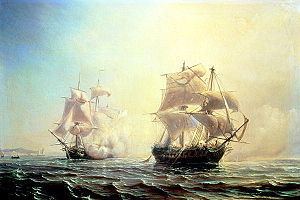Name Embuscade In service June 1790 Construction started 1788 Length 44 m Draft 5.7 m | Namesake "Ambush" Laid down 1788 Captured 12 October 1798 Launched 21 September 1789 Weight 560 tons | |
 | ||
The Embuscade ("Ambush") was a 32-gun frigate. She served in the French Navy during the War of the First Coalition before being captured by the British. Renamed the Ambuscade and later the Seine, she participated in the Napoleonic Wars in the Royal Navy.
Contents
French service
Embuscade, launched in 1789, was constructed in Rochefort. Her captain was Jean-Baptiste-François Bompart, a former privateer who fought in the American War of Independence. In 1792, she escorted convoys to and from Martinique, and ferried Edmond-Charles Genêt to the United States. During the early years of the war, she raided British shipping along the American east coast.
Embuscade arrived in Charleston, South Carolina, on 8 April 1793. She brought Edmond-Charles Genêt to take up his post as the French ambassador to the United States. Then on 31 July, she fought and severely damaged HMS Boston at the action of 31 July 1793. Embuscade returned to France a year later and took part in the Croisière du Grand Hiver in 1795 as part of Pierre Jean Van Stabel's squadron.
On 7 March 1795 Embuscade captured the Queen, which was sailing from Tenerife, Canary Islands to London.
Capture and French Revolutionary Wars
In 1798 Captain Bambot was given command of a squadron of ships, including the Embuscade, with orders to transport troops to Ireland to fight in the Irish Rebellion of 1798. Along the way, a British fleet learned of the French squadron's position and gave chase. The two forces fought at the Battle of Tory Island, which ended in a decisive French defeat. Embuscade was captured and added to the Royal Navy as Ambuscade.
She was commissioned in August 1800 under the command of Captain the Honourable J. Colvill. On 26 March 1801 she sailed for Jamaica but by 1802 she was back in the English Channel. In September 1802, while under the command of Captain David Colby she became the flagship for Rear-Admiral Edward Thornbrough in the North Sea.
Napoleonic Wars
On 27 August 1803, while under the command of Captain David Atkins, she captured the Hendrick and Jan.
She was renamed HMS Seine in 1804, as the previous Ambuscade had been retaken and was recommissioned under her old name, and the previous Seine had just been lost. In early 1805, Seine captured several vessels on the Jamaica station. The first capture, on 29 January, was the Spanish schooner San Ignacio, which was carrying sundries and which was declared a Droit of Admiralty.
Then on 30 April she captured the French privateer schooner Perseverante. Perseverante was armed with one 12-pounder gun and four 4-pounders, and had a complement of 90 men, of whom 84 were on board at the time of her capture. She was from Guadeloupe and had been out 12 days, during which she had captured the English sloop Apollo, of Bermuda. Capturing Perseverante required a chase of three hours as she was remarkable fast sailing. She was three years old, newly coppered and fastened with "composition bolts"; the description was perhaps notice to the Admiral of the station that the Royal Navy might consider buying her.
On 27 May Seine's barge, under the command of Lieutenant Bland of the Marines, captured the recently constructed Spanish schooner Conception off Puerto Rico. Conception was armed with two 6-pounder guns and had a crew of 10 men. She had some nine passengers on board who resisted, but then escaped on shore. She was from Santa Maxta Martha and was carrying a cargo of log wood. Atkins captured nine prisoners who he quickly landed as they appeared ill and he wished to avoid introducing sickness into Seine.
By coincidence, on 18 June, Bland and the barge captured a second Conception, this one a felucca of two long 4-pounder guns and carrying a crew of 14 men. The Spanish resisted for three-quarters of an hour before surrendering. In the action they suffered five men wounded; the British had no casualties. The felucca was carrying cocoa and cochineal from Puerto Rico to Cadiz. On his short cruize with the barge, Bland also destroyed a Spanish sloop.
On 29 June Seine aided Unicorn, Comet and Cossack in capturing the French brig Pierre Caesar off the coast of France. The Admiralty took Pierre Caesar into service as Tigress.
On 26 December 1807, Seine captured the French privateer lugger Sybille at {{coord|49|27|N|8|30 W]]. Sybille had a crew of 43 men and was pierced for 14 guns but had only one long gun on board, as well as some swivel guns and small arms. She was five days out of Morlaix but had taken no prizes.
Fate
Seine was broken up in 1813.
